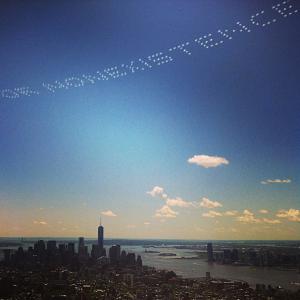
'Existence or Nonexistence', skywriting over New York City; from the project 'Severe Clear', 2014
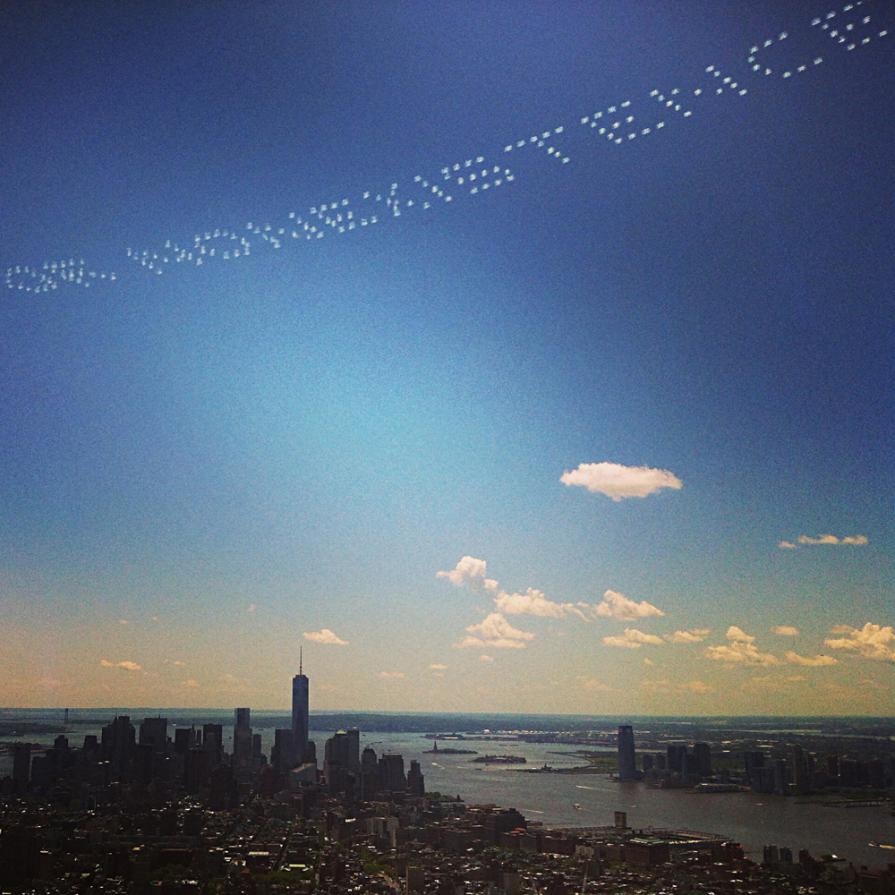
'Existence or Nonexistence' was the first part of a two-part project titled 'Severe Clear'. On Memorial Day Sunday, the words EXISTENCE OR NONEXISTENCE appeared briefly in skywriting above the Manhattan skyline. The phrase was extracted from a letter sent by the Central Intelligence Agency to the American Civil Liberties Union rejecting their Freedom of Information Act request for records relating to the US government’s classified drone program. The full reply reads, ‘...the CIA can neither confirm nor deny the existence or nonexistence of records responsive to your request.’ [See main description for more details.]

Original letter from the CIA to the ACLU, dated 9 March 2010

The phrase 'Existence or Nonexistence' was extracted from a letter sent by the Central Intelligence Agency to the American Civil Liberties Union rejecting their Freedom of Information Act request for records relating to the US government’s classified drone program. The full reply reads ‘...the CIA can neither confirm nor deny the existence or nonexistence of records responsive to your request.’ [See main description for more details.]
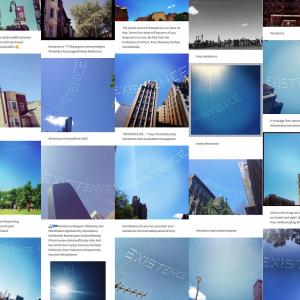
'Existence or Nonexistence', from the project 'Severe Clear'; skywriting images posted to social media by people across New York City on Memorial Day Sunday
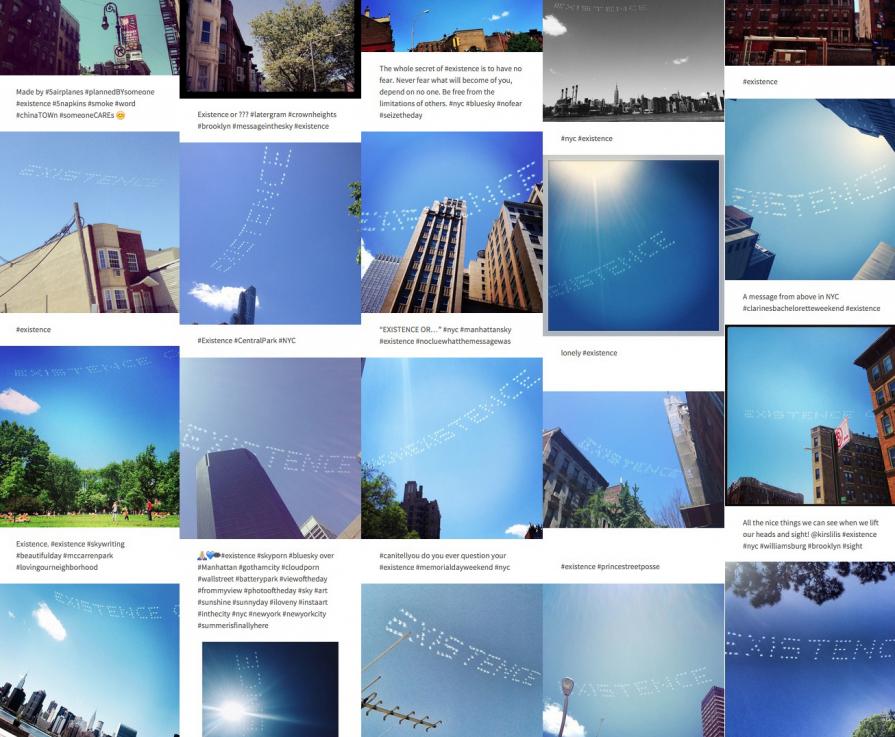
Images of the skywriting were posted to social media by people across the city. A little over a week later, the CIA’s public relations department officially joined Twitter with its maiden message: ‘We can neither confirm nor deny that this is our first tweet.’ [See main description for more details.]
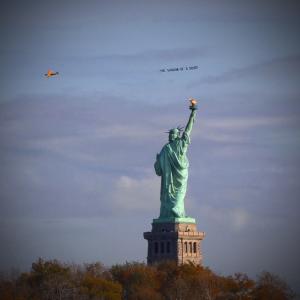
'The Shadow of a Doubt', airplane banner circling The Statue of Liberty; from the project 'Severe Clear', 2014
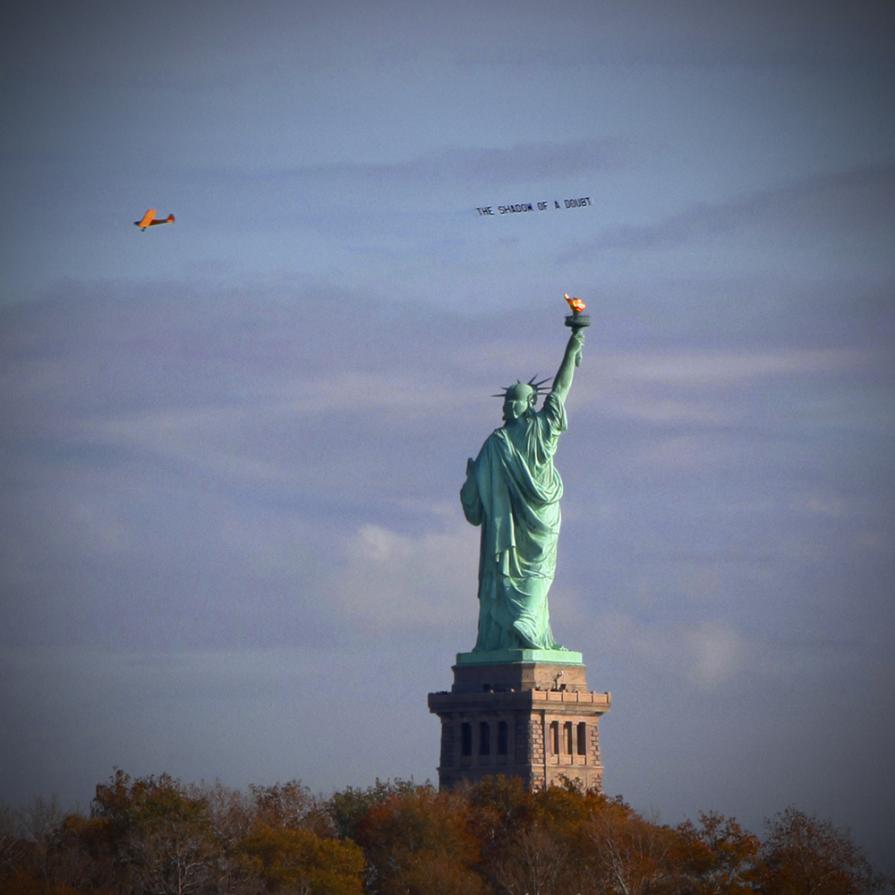
‘The Shadow of a Doubt' was the second part of a two-part project titled 'Severe Clear'. On Veterans Day, at the eleventh hour of the eleventh day of the eleventh month, a small plane began circling the Statue of Liberty’s torch towing a banner that read THE SHADOW OF A DOUBT. In British and American courts, juries are asked to convict or acquit on the basis of reasonable doubt, since proving a defendant’s guilt beyond the shadow of a doubt is all but impossible. As such, it is the highest standard of justice to which a society can strive — a jurisprudential ideal that contrasts sharply with the circumstantial evidence often used to authorise drone strikes. [See main description for more details.]
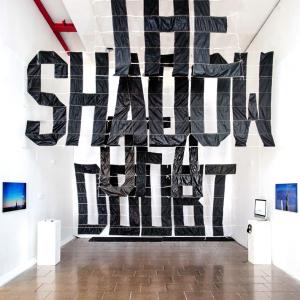
'The Shadow of a Doubt' from the project 'Severe Clear'; installation view of airplane banner
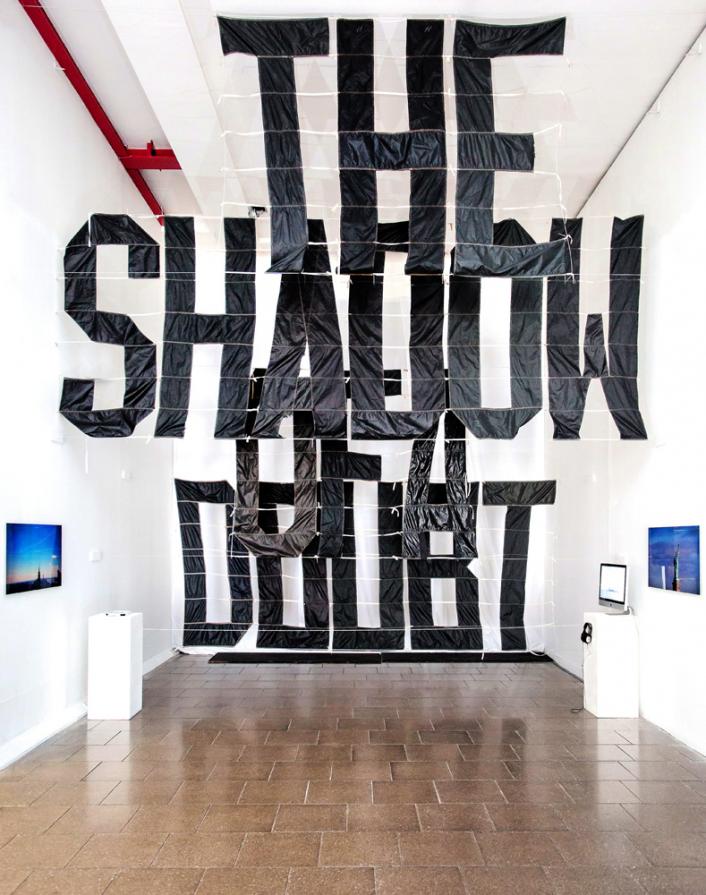
This is a documentation image of the original banner flown around The Statue of Liberty on Veterans Day. The banner has been exhibited as part of a wider installation comprising photography, video, text, and social media images on iPads at University of the Arts, London; the Casino, Luxembourg; the Benaki Museum, Athens; and the Whitney Museum ISP, New York.
'Severe Clear'
A few moments after noon on Memorial Day Sunday, the words ‘EXISTENCE OR NONEXISTENCE’ appeared briefly in synchronised bursts of smoke across the skyline of Manhattan. The phrase was extracted from a letter sent by the Central Intelligence Agency to the American Civil Liberties Union rejecting their Freedom of Information Act request for documents relating to the US Government’s classified drone program. The full reply reads, ‘...the CIA can neither confirm nor deny the existence or nonexistence of records responsive to your request.’
My intent in re-contextualising this phrase — transplanting it from a legal document into something as ethereal and ephemeral as white clouds in a blue sky — was to open it up to multiple readings; and as images of the skywriting spread across social media, people’s varied and fantastical interpretations clearly underscored the nebulous nature of the government’s legalistic response. Viewed from below, some understood the words as a philosophical proposition, or an agnostic response to the question of faith, while others assumed it to be a reference to Hamlet’s ‘To be or not to be’ soliloquy and a meditation on the afterlife, or a rumination on the existence of UFOs: an apt question, given the rapid proliferation of drones, or UAVs (‘unmanned aerial vehicles’) in military parlance, over the past two decades. The realisation that this was in fact carefully worded legalese came as a surprise to many. Then, a little over a week later, in what seemed an unlikely coincidence, the CIA’s public relations department officially joined Twitter with its maiden message: ‘We can neither confirm nor deny that this is our first tweet.’
If truth is the first casualty of war, so is the vocabulary that sustains it. As Orwell states in his essay Politics and the English Language, ‘…political language has to consist largely of euphemism, question-begging and sheer cloudy vagueness.’ My interest lies in the cloudy wording of the government’s rejection letter — a linguistic somersault that takes judicial precision and spins it into a kind of esoteric, existential rhetoric. Like a line from Kafka composed in bureaucratic prose, it tells us, in the most precise terms, nothing, except that the absence of affirmation does not imply it exists. Whatever ‘it’ may be. On the day of the skywriting, I went to the top of the Empire State Building and took a photograph while facing south toward the rebuilt World Trade Center’s new Freedom Tower. This tension between the social, economic, and ideological conceptions of freedom and empire is, for me, an important part of the work.
A follow-up performance on Veterans Day, at the eleventh hour of the eleventh day of the eleventh month, saw a small plane circle the Statue of Liberty's torch towing a banner that read ‘THE SHADOW OF A DOUBT’. The term refers to an unattainable burden of proof. In British and American courts, juries are asked to convict or acquit on the basis of a reasonable doubt, since proving a defendant’s guilt beyond the shadow of a doubt is all but impossible. As such, it signifies an abstract and absolute level of truth: a jurisprudential ideal that contrasts sharply with the circumstantial evidence often used to authorise drone strikes.
Memorial Day and Veterans Day are public holidays commemorating the lives of Americans who have died or served during wartime. They are resonant dates, given the implications of drone warfare — which has brought about a decrease in the number of US casualties, coupled with an increase in the number of civilian casualties in countries such as Pakistan, Afghanistan, Iraq, Yemen, and Somalia.
Skywriting was developed by British air force pilots during the First World War as a way of communicating messages over long distances. The title of the work, 'Severe Clear', is an aviation term used to describe ideal flying — and bombing — conditions. 'Liberty Enlightening the World', the original name of Frédéric Bartholdi’s colossal statue of the Roman goddess Libertas, watches over New York, and has greeted immigrants to the United States for more than a century. Her torch symbolises equality and transparency under the law.
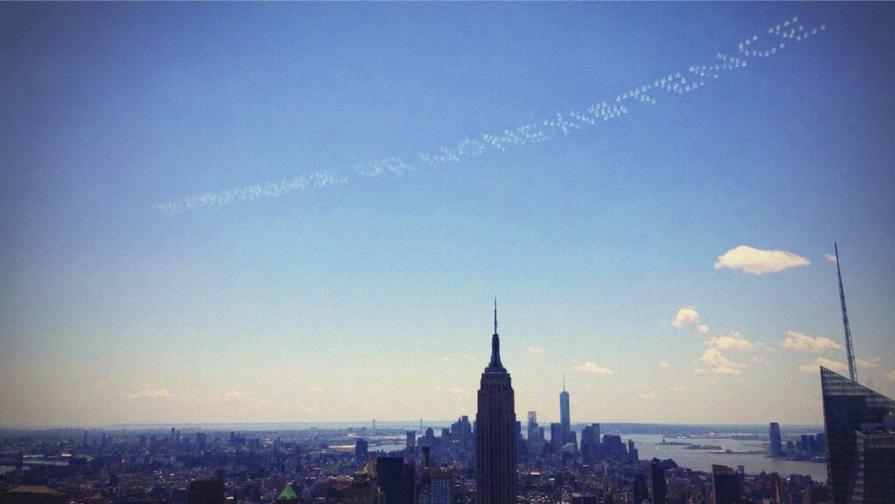
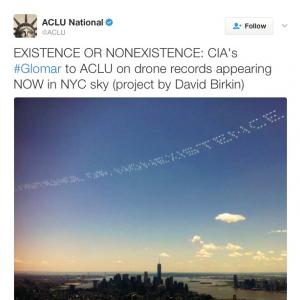
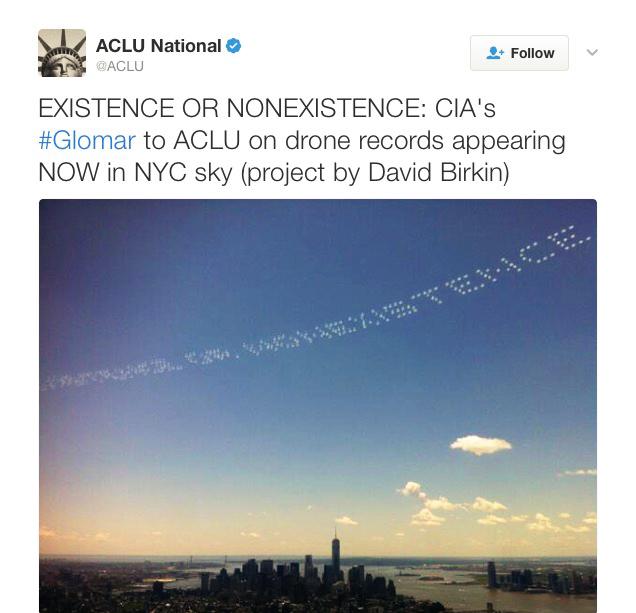

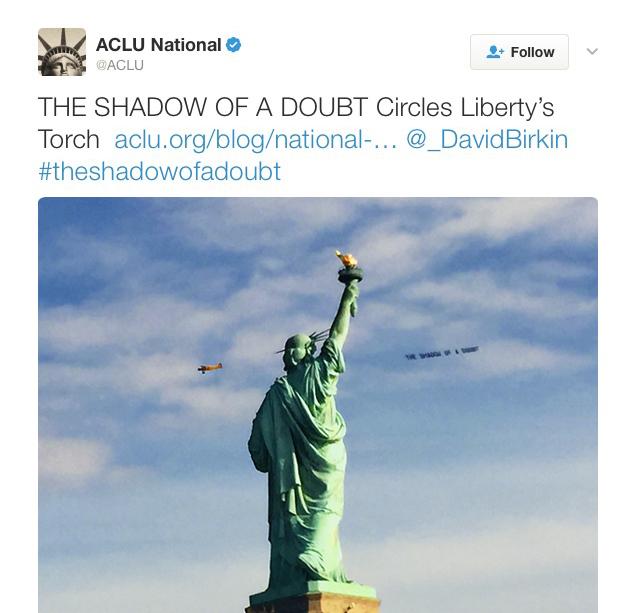
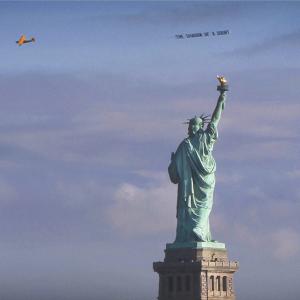
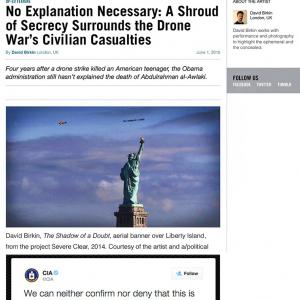
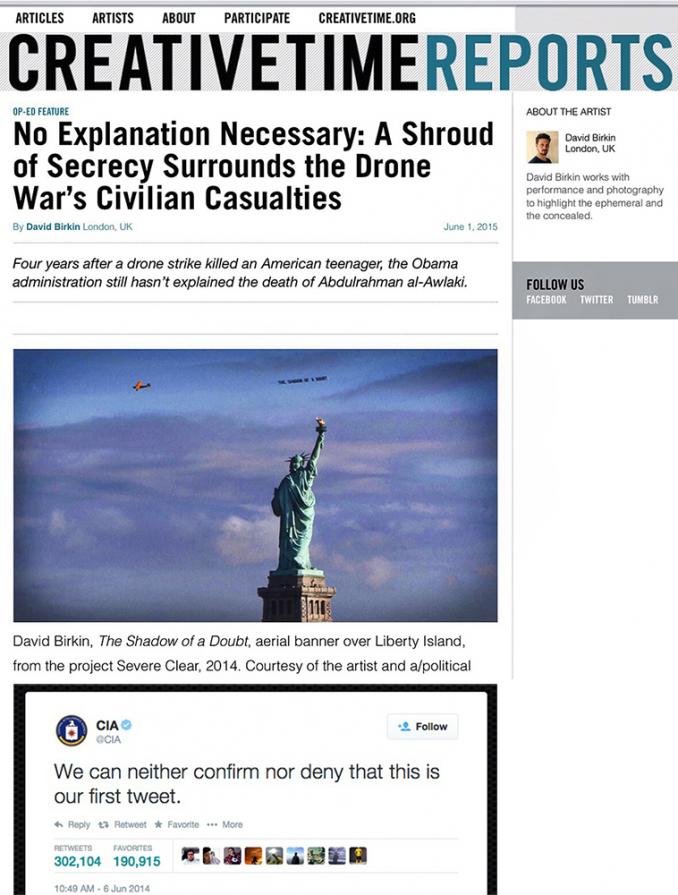











Comments 0
Say something